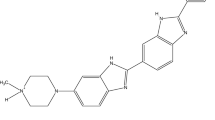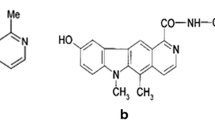Abstract
Quantitative structure–activity relationship (QSAR) is an attempt to correlate structural or property descriptors of compounds quantitatively with biological activities. QSARs currently are being applied in many disciplines, with many pertaining to drug design and environmental risk assessment. The 3D QSARs between the structures of 29 quinoline compounds and their topoisomerase-II inhibitor activity have been developed using the comparative molecular field analysis (CoMFA), comparative molecular similarity indices analysis (CoMSIA), and stepwise k nearest neighbor molecular field analysis [(SW) kNN MFA] method, and 3D QSAR models with the considerable prediction ability are obtained. The CoMFA, CoMSIA, and [(SW) kNN MFA] studies resulted in reliable and significant computational models. These models are more significant guide to trace the important chemical features with respect to the design of new potent compounds. The information obtained from the CoMFA, CoMSIA, and [(SW) kNN MFA] contour maps can be utilized for the design and development of new, more potent topoisomerase-II inhibitor.










Similar content being viewed by others
References
Ajmani S, Jadhav K, Kulkarni SA (2006) Three-dimensional QSAR using the k-nearest neighbor method and its interpretation. J Chem Inf Model 46:24–31
Baloch Z, Cohen S, Coffman FD (1990) Synergistic interactions between tumor necrosis factor and inhibitors of DNA topoisomerase I and II. J Immunol 145:2908–2913
Buzdar AU (2006) Topoisomerase IIα gene amplification and response to anthracycline-containing adjuvant chemotherapy in breast cancer. J Clin Oncol 24:2409–2411
Chen YL, Chen IL, Wang TC, Han CH, Tzeng CC (2005) Synthesis and anticancer evaluation of certain 4-anilinofuro[2,3-b]quinoline and 4-anilinofuro[3,2-c]quinoline derivatives. Eur J Med Chem 40:928–934
Chen YL, Huang CJ, Huang ZY, Tseng CH, Chang FS, Yang SH, Lin SR, Tzeng CC (2006) Synthesis and antiproliferative evaluation of certain 4-anilino-8-methoxy-2-phenylquinoline and 4-anilino- 8-hydroxy-2-phenylquinoline derivatives. Bioorg Med Chem 14:3098–3105
Duguet M (1997) When helicase and topoisomerase meet! J Cell Sci 110:1345–1350
Jing C, Xiaowu D, Tao L, Jianshu L, Chaoyi J, Wenhai HQH, Bo Y, Yongzhou H (2009) Design, synthesis, and quantitative structure–activity relationship of cytotoxic γ-carboline derivatives. Bioorg Med Chem 17:3324–3331
Kallenbach S, Brinkmann T, Rougeon F (1993) Rag-1: a topoisomerase? Int Immunol 5:231–232
Lee BD, Li Z, French KJ, Zhuang Y, Xi Z, Smith CD (2004) Synthesis and evaluation of dihydropyrroloquinolines that selectively antagonize P-glycoprotein. J Med Chem 47:1413–1422
Lee SH, Van HTM, Yang SH, Lee KT, Kwon Y, Cho WJ (2009) Molecular design, synthesis and docking study of benz[b]oxepines and 12-oxobenzo[c]phenanthridinones as topoisomerase 1 inhibitors. Bioorg Med Chem Lett 19:2444–2447
Prashanthakumar BR, Nanjan MJ (2010) Comparative molecular similarity indices analysis for predicting the antihyperglycemic activity of thioglitazones. Med Chem Res 19:1000–1010
Prashanthakumar BR, Sankar G, Baig RBN, Chandrashekaran S (2009) Novel Biginelli dihydropyrimidines with potential anticancer activity: a parallel synthesis and CoMSIA study. Eur J Med Chem 44:4192–4198
Ravichandran V, Agrawal RK (2007) Predicting anti-HIV activity of PETT derivatives: CoMFA approach. Bioorg Med Chem Lett 17:2197–2202
Ravichandran V, Jain PK, Mourya VK, Agrawal RK (2007a) QSAR study on some arylsulfonamides as anti-HIV agents. Med Chem Res 16:342–351
Ravichandran V, Mourya VK, Agrawal RK (2007b) QSAR study of novel 1, 1, 3-trioxo [1, 2, 4]-thiadiazine (TTDs) analogues as potent anti-HIV agents. Arkivoc 14:204–212
Ravichandran V, Sankar S, Agrawal RK (2008) Comparative molecular similarity indices analysis for predicting anti-HIV activity of phenyl ethyl thiourea (PET) derivatives. Med Chem Res 17:1–11
Staker BL, Hjerrild K, Feese MD, Behnke CA, Burgin ABJ, Stewart L (2002) The mechanism of topoisomerase I poisoning by a camptothecin analog. Proc Natl Acad Sci 99:15387–15392
Su TL, Chou TC, Kim JY, Huang JT, Ciszewska G, Ren WY (1995) 9-substituted acridine derivatives with long half-life and potent antitumor activity: synthesis and structure–activity relationships. J Med Chem 38:3226–3235
Wang JC (1996) DNA topoisomerases. Ann Rev Biochem 65:635–692
Acknowledgments
We would like to thank Dr. G. Narahari Sastry, Head of the department, Molecular Modeling Group, IICT Hyderabad, India, for providing access to computational resources and for their valuable help during the modeling studies.
Conflict of interest
The authors confirm that this article content has no conflicts of interest.
Author information
Authors and Affiliations
Corresponding author
Rights and permissions
About this article
Cite this article
Vaidya, A., Jain, S., Jain, A.K. et al. Computational analysis of quinoline derivatives as potent topoisomerase-II inhibitors. Med Chem Res 24, 383–393 (2015). https://doi.org/10.1007/s00044-014-1131-9
Received:
Accepted:
Published:
Issue Date:
DOI: https://doi.org/10.1007/s00044-014-1131-9




